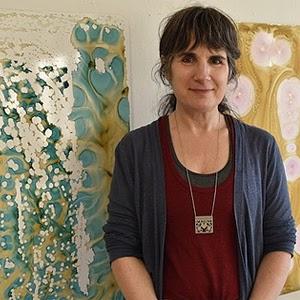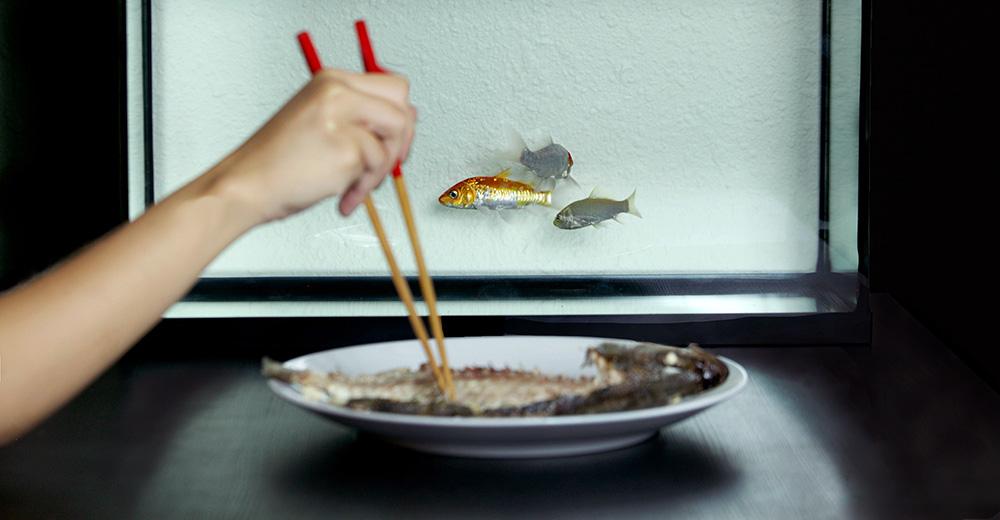Jenny Krauss

Jenny Krauss is a lifelong painter who’s been working with families in Latin America as a part of her textile wholesale business. Her paintings in our Modicum exhibit are all made with gouache on board and feature unique patterns and color varieties. The following is a transcripts from an interview conducted by Annissa Carter as a part of out Artists of New Haven program.
I moved to New Haven from NYC in 2018. My husband’s been working in New Haven since 1993 and after decades of being a dual city couple, I made the decision to become a full time CT resident. This interview is about my paintings but I founded a textile company over twenty years ago and needed an office in Manhattan. I moved that office up here as well which, given Covid-19, turned out to be a good idea. New Haven has a lot to offer and I enjoy living here.
Prior to starting my company, I got a BFA and an MFA and worked as an artist through my 20s and 30s. Living on “day job” salaries became tiresome and I decided to become an entrepreneur. That endeavor started slowly but the business grew as I focused more and more on handmade weaving and embroidery from Latin America. Today my company employs 900 indigenous women from the highlands of Peru. It brings a lot of meaning to my life because these artisans have no other opportunities for employment. I get to be creative and help people at the same time. I sell primarily to retailers and only maintain a small website for selling directly to the public. I’m very old school that way and have no interest in selling on Amazon or competing with my loyal customers.
After a nearly two-decade hiatus, in 2017 I went into my apartment’s small kitchen and started painting again, using the countertop as my “easel.” When I moved to New Haven I rented a space at MarlinWorks which has a lot of artist’s studios. A neighbor there told me about Artspace and I participated in Open Studios. Meeting other artists who’ve been in New Haven for a long time has been a wonderful experience and getting into the Flat File show is an honor. A gallery holding eight paintings for a year is a great opportunity.
Tell me a bit more about your art style, do you lean into a particular medium?
I use gouache. When I started in my kitchen, I needed to use something water based because I had to cook there as well. I didn’t want to use anything that’s smelly or messy. This work is nothing like what I used to do before I stopped painting. I just started having fun and pushing paint around. I use a very slick surface that’s non-absorbent, so I had to learn the various properties of different colors to get it to adhere. It felt like a chemistry experiment. Control was not possible and I liked that. I used to be much more uptight and would obsess about getting all parts of the painting just right. While attempting to do that I’d try to fix areas and end up ruining the whole thing. This new process determined the imagery and gave me the freedom to loosen up. I will try something, and if I don’t like it, I wash it all off and start over. For each painting, the final picture comes pretty quickly, but it’s an educated accident and there are many other washed away paintings that came before. I find this process exciting and it keeps me on my toes. It’s a whole new experience every time I try something.
What’s been inspiring your art lately and what are some new things you’ve been trying out?
The inspiration is to not repeat myself. When I first started that was easier to do because it was all new and I was discovering the possibilities. But three years later I felt that I was getting repetitive. I know that’s a thing in the art world; you hit on something that clicks with an audience and then churn out more of the same, but I don’t really go for that. I’ve been trying to juxtapose things differently and use a new palette. I’m moving the brush around in new ways, adding hard edges, cutting into the surface. All to keep the level of experimentation and surprise up.
For example, one painting I just finished has multiple shades of green that I associate with landscapes. It inspired me to create shapes and connections that were different from what I’d been doing.
You have a background in textiles, do you make them yourself or do you manufacture and sell them?
I started out making them myself, but I couldn’t keep up. It took too long and I wanted to wholesale them so production was needed.
My first product was a re-imagining of a handmade vintage doll, call a yo-yo doll. Quilters made them with their excess fabric from the 1920’s-70’s. It took me three days to make each one. Finding production in the US was difficult so I conferred with Aid to Artisans, a non-profit that works with artisans worldwide. They connected me to a group of skilled women in Bolivia. The dolls sold well and that led me to meeting women throughout Latin America who had all kinds of weaving and embroidery skills. I wanted to provide work so I started collaborating with them; my designs, their craftsmanship. I draw on the computer but their work is done entirely by hand. In addition to Bolivia, I’ve worked in El Salvador, Guatemala, and Mexico. These days, I work primarily in Ayacucho, a region in the Peruvian Andes. If you look at my website, jennykrauss.com, you can read the whole story and see the video about it.
Does your experience with embroidery and textiles influence your artwork today?
Yes and no. At one point I tried to make paintings that were more like the drawings I send down to South America, but they weren’t interesting to me. However, I’m always working with patterns and repeats and I do consider those elements when I’m painting. It’s interesting that you ask though, because one ambition I have is to curate an exhibit about the people I work with that would show the process from initial concept to finished product. Also, some of the embroiderers design and create their own one-of-a kind pieces and it would be nice for them to get recognition for that. These are often large tapestries that are difficult for me to sell.
Has the pandemic changed how you’ve been able to do your wholesale and connect with your art?
Last March I thought I was going to be out of business by the end of the year because, as you remember, it felt like the sky was falling. Fortunately, my largest customers came through without a drop in sales and my orders weren’t reduced or cancelled. 2020 turned out better than 2019.
COVID hit Peru badly and they have a terrible health care system, especially for the indigenous. Because of dire poverty, you have multi-generational families living in small spaces. They can’t afford to stock up on food so they shop in crowded markets on a daily basis. Even though they went into lockdown quickly it still took off in Lima and then spread to the provinces. Sadly, one of the families I work with, a husband, wife and two children, all got COVID last summer. The husband was deathly ill and they couldn’t help him at all in Ayacucho. His daughter contacted me and some other people who work in US non-profits and we teamed up to save him. Money was transferred to get him on a plane to Lima and everyone tried to find contacts who could help. We located one hospital with a bed that would take him. He recovered, but for a couple of weeks we were all frantic. So yes, it got really bad but all his medical expenses have been paid and production didn’t suffer so the enterprise his family runs continues to thrive.
Related Exhibition
